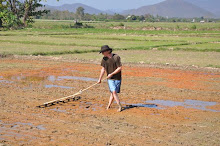This NY Times article is just one more example why Americans should demand more accountability in the agriculture and food production sectors. I'm not talking about more regulation. I'm talking about consumers having access to all the facts about where their food comes from.
http://www.nytimes.com/2010/02/25/business/25tomatoes.html?scp=2&sq=tomato%20&st=cse
Friday, February 26, 2010
Tuesday, February 23, 2010
A stunted green revolution
Too much Urea has sterilized the Indian soil. A recent article published by the Wall Street Journal Online tells the story of mismanagement of the Nitrogen fertilizer in India.
Will Indian farmers respond by using more complex chemical fertilizers? Or will they learn to adapt more sustainable approaches? Click on the link below for more information.
http://online.wsj.com/article/SB10001424052748703615904575052921612723844.html?mod=wsj_share_facebook
Will Indian farmers respond by using more complex chemical fertilizers? Or will they learn to adapt more sustainable approaches? Click on the link below for more information.
http://online.wsj.com/article/SB10001424052748703615904575052921612723844.html?mod=wsj_share_facebook
Tuesday, February 16, 2010
India's Counter Green Revolution
An interesting event has occurred in India. The Environment and Forestry Ministry has put an indefinite ban on the sale of genetically modified eggplant seeds until a broader consensus within the country can be reached regarding the use of this particular seed. No doubt the ministry's hesitation reflects the growing unease around the world regarding the use of GMOs. The use of GMOs are controversial. Despite their higher yields and resistance to common pests many farmers and scientists are concerned about the legal, ethical, and biological implications of using GMOs.
The particular seed was developed by a subsidiary of Monsanto in India. Monsanto is one of the largest biotech companies in the world.
This particular seed is modified to deal with a common pest that destroys 40% of India's eggplant production each year. It sounds like a good piece of technology. However, a few important questions need to be asked before we support the use of this GMO.
First, are there farmers in India who have been able to control the pests this seed will deter? If so, what are they doing? I would imagine that there are innovative and local solutions to this local problem. Farmers are smart. In particular are there farmers who are using integrated pest management (IPM) successfully? IPM is technique that uses several different methods of pest control including soil management, crop rotation, traps, and poly-culture.
Second, when did this particular pest become a problem? Has it always been a problem or is it a historically new phenomenon? If it is new (15-20) years then we have to ask what has changed in the environment or methods? Could that be the source of the pest? Why pull the mother out of the river down stream when you can save a mother and child up stream?
Third, it is important to review the literature that documents pests and disease resistance to GMOs. How long will it take for these pests to develop a resistance to the GMO?
http://www.businessweek.com/news/2010-02-10/india-rejects-first-gm-vegetable-hampering-monsanto-update1-.html
http://online.wsj.com/article/SB40001424052748704140104575058383515565108.html
The particular seed was developed by a subsidiary of Monsanto in India. Monsanto is one of the largest biotech companies in the world.
This particular seed is modified to deal with a common pest that destroys 40% of India's eggplant production each year. It sounds like a good piece of technology. However, a few important questions need to be asked before we support the use of this GMO.
First, are there farmers in India who have been able to control the pests this seed will deter? If so, what are they doing? I would imagine that there are innovative and local solutions to this local problem. Farmers are smart. In particular are there farmers who are using integrated pest management (IPM) successfully? IPM is technique that uses several different methods of pest control including soil management, crop rotation, traps, and poly-culture.
Second, when did this particular pest become a problem? Has it always been a problem or is it a historically new phenomenon? If it is new (15-20) years then we have to ask what has changed in the environment or methods? Could that be the source of the pest? Why pull the mother out of the river down stream when you can save a mother and child up stream?
Third, it is important to review the literature that documents pests and disease resistance to GMOs. How long will it take for these pests to develop a resistance to the GMO?
http://www.businessweek.com/news/2010-02-10/india-rejects-first-gm-vegetable-hampering-monsanto-update1-.html
http://online.wsj.com/article/SB40001424052748704140104575058383515565108.html
Subscribe to:
Comments (Atom)
